Winter might be in full-swing at the moment, but warm nights and backyard barbeques are right around the corner. And neither are complete without a proper fire pit. Whether you want to heat up your outdoor space with wood or propane, there are plenty of “fire feature” options out there, from a stone fire pit to a chiminea.
I’ve narrowed this list of recommendations to genuine, wood-burning fire pits, so you won’t find any gas or propane fire pits here. After all, nothing beats a wood fire pit when it comes to ease of use and versatility — you can use it as a bonfire or for cooking food, including grilling. And most importantly, a wood fire offers a great way to roast marshmallows for gooey, delicious s’mores.
Some of the best fire pits are portable, so you don’t need to commit to building a permanent one in your yard. Major retailers such as Amazon, Home Depot and Lowe’s carry them, and you can also buy directly from fire pit manufacturers.
Transportable outdoor fireplaces differ widely in size, weight and price. You can find inexpensive $60 models and high-performance pits that’ll set you back as much as $350. You can even spend $1,500 or more on a fancy propane fire pit. Lots of them also come with extras like a cooking grate, so if you’re feeling extra outdoorsy, you can grab your cast-iron cookware and make your dinner over the embers in your backyard fire pit instead of the kitchen.
Read more: 4 reasons you should use a cast-iron skillet to grill burgers
The models on this list are all from established outdoor brands, and they’re either bestsellers, highly ranked or worthy challengers for the best fire pit. There are various kinds available, such as a fire pit table, stone fire pit and tabletop fire pit. We tested many backyard fire pits to determine their strengths and weaknesses, as well as the quality of the tools that come with them, whether that’s a cooking grate or just a fire poker. So, ready to gather round the bonfire? Let us help you choose the best wood fire pit for your backyard or patio. We’ll update this list periodically.
Best Fire Pits for 2022

 \n ","topic":"","ttag":"","variant":"","viewguid":"","event":"listicle|image|1","correlationId":"","_destCat":"https:\/\/www.amazon.com\/Tiki-Brand-Stainless-Steel-Smoke\/dp\/B082XHVGZM","productName":"Best fire pit overall","formatType":"IMAGE","location":"LIST","position":1,"sku":"","dwLinkTag":"article-body|listicle|image","selector":"#article-body #listicle-df4a66fe-aacf-4233-92a7-270c2321ec48 .itemImage"}}” rel=”noopener nofollow” target=”_blank”>
\n ","topic":"","ttag":"","variant":"","viewguid":"","event":"listicle|image|1","correlationId":"","_destCat":"https:\/\/www.amazon.com\/Tiki-Brand-Stainless-Steel-Smoke\/dp\/B082XHVGZM","productName":"Best fire pit overall","formatType":"IMAGE","location":"LIST","position":1,"sku":"","dwLinkTag":"article-body|listicle|image","selector":"#article-body #listicle-df4a66fe-aacf-4233-92a7-270c2321ec48 .itemImage"}}” rel=”noopener nofollow” target=”_blank”>


Brian Bennett/CNET
Our favorite fire pit on this list is made by Tiki, a company that began with the familiar Tiki bamboo torch over 60 years ago. Now Tiki offers a fire pit that’s large, sturdy and attractive. Priced almost $300 more than its budget rivals, this pit has performance, ease of use and superior style that make it worth the investment.
The steel and stained-wood pit doesn’t just look good. The Tiki Brand Fire Pit has a clever airflow system that recycles hot smoke back into the fire chamber. During our testing, it was easy to ignite, firing up in about 5 minutes and fully burning in 15.
It also generated far less smoke than the other fire pits we tested, especially after its logs caught fully, usually at about the 15-minute mark. Only the Solo Stove Ranger burned wood with less smoke emission, its fuel burning fiercely in 5 minutes. The Tiki Fire Pit’s logs burned efficiently as well, lasting for hours.
Because of its large (16 inches in diameter) mouth, it’s easier to share the fire with multiple people. The Solo Stove Ranger is smaller, with a metal fire ring of 10 inches in diameter. Kids gathering around to roast s’mores need to be careful, though: All surfaces of the Tiki fire pit, including its metal lip, are scalding hot after the fire is lit. It also takes time to cool after the flames die down.
We do appreciate the Tiki Brand pit’s removable ash pan. It makes for easy cleanup. The pit puts out a generous amount of heat; while that’s perhaps not ideal for hot summer nights, it’s excellent when the temperature dips during the fall and winter. Finally, tipping the scales at 45 pounds, this fire pit is heavy. Think twice before you position it, and get help when you do.

 \n ","topic":"","ttag":"","variant":"","viewguid":"","event":"listicle|image|2","correlationId":"","_destCat":"https:\/\/www.solostove.com\/solo-stove-yukon\/","productName":"Best smokeless fire pit","formatType":"IMAGE","location":"LIST","position":2,"sku":"","dwLinkTag":"article-body|listicle|image","selector":"#article-body #listicle-ec09380b-5ce5-48e2-b75f-e486fb54f625 .itemImage"}}” rel=”noopener nofollow” target=”_blank”>
\n ","topic":"","ttag":"","variant":"","viewguid":"","event":"listicle|image|2","correlationId":"","_destCat":"https:\/\/www.solostove.com\/solo-stove-yukon\/","productName":"Best smokeless fire pit","formatType":"IMAGE","location":"LIST","position":2,"sku":"","dwLinkTag":"article-body|listicle|image","selector":"#article-body #listicle-ec09380b-5ce5-48e2-b75f-e486fb54f625 .itemImage"}}” rel=”noopener nofollow” target=”_blank”>
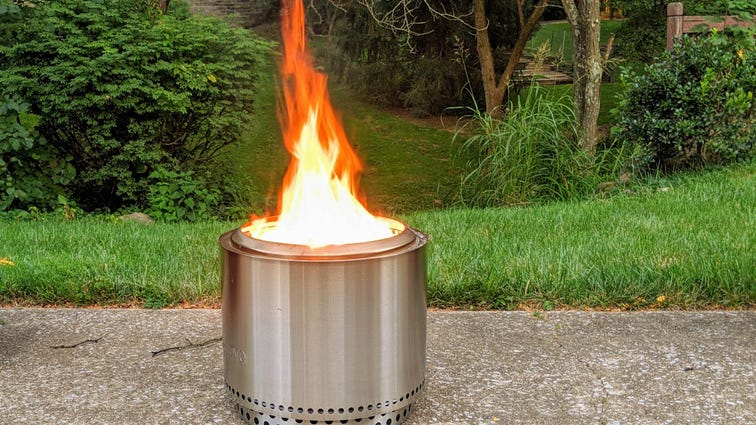

Brian Bennett/CNET
Solo Stove fire pits have gained an avid following in recent years, and the company’s newest product, the Solo Stove Yukon, is its biggest and best yet. With a top that measures 27 inches across and a mouth 23 inches in diameter, the Yukon is large enough to accept full-size firewood logs. Despite the Yukon’s wide footprint, its stainless-steel body gives it a sleek appearance.
The Yukon shares the same sophisticated airflow system you’ll find on other Solo Stove products. According to Solo Stove, these vents help drive a continuous supply of oxygen to its fire. In our experience, the Yukon delivers performance just as good as its smaller cousin, the Solo Stove Ranger, but on a larger scale.
The Yukon’s fire starts fast: Its logs fully caught in just 5 minutes. Once they caught, they burned for hours. This pit was efficient too, consistently consuming all of our test firewood logs. At the end of the night, there was little solid debris to speak of, merely a few bits of charcoal and ash. It produces a lot less smoke than the other fire pits we’ve tested here, save the Solo Pit Ranger.
You can also order the Yukon with a rain cover ($60) and a metal stand ($65) for extra cash or as part of a bundle. Because the pit weighs 38 pounds, we don’t recommend moving it often on your patio or in your yard. Also, as with other high-performance fire pits, kids (and adults) need to be careful around the Yukon. In addition to the intense heat from the fire itself, the Yukon’s steel surface heats to burning temperatures fast.

 \n ","topic":"","ttag":"","variant":"","viewguid":"","event":"listicle|image|3","correlationId":"","_destCat":"https:\/\/breeo.co\/products\/x-series-24-smokeless-fire-pit","productName":"Best durable fire pit","formatType":"IMAGE","location":"LIST","position":3,"sku":"","dwLinkTag":"article-body|listicle|image","selector":"#article-body #listicle-feae22e0-6195-4dc6-905f-bd7ca9bed0a5 .itemImage"}}” rel=”noopener nofollow” target=”_blank”>
\n ","topic":"","ttag":"","variant":"","viewguid":"","event":"listicle|image|3","correlationId":"","_destCat":"https:\/\/breeo.co\/products\/x-series-24-smokeless-fire-pit","productName":"Best durable fire pit","formatType":"IMAGE","location":"LIST","position":3,"sku":"","dwLinkTag":"article-body|listicle|image","selector":"#article-body #listicle-feae22e0-6195-4dc6-905f-bd7ca9bed0a5 .itemImage"}}” rel=”noopener nofollow” target=”_blank”>


Brian Bennett/CNET
To say the Breeo X Series 24 is built to take a beating is an understatement. Manufactured in Lancaster, Pennsylvania, the X Series is constructed from a mix of corten (weathering) steel and 304 stainless steel. As a result, the X Series doesn’t require a rain cover or weather shelter. In fact, after six months of exposure to the elements, the outer wall of the fire pit develops a natural patina that protects it from corrosion.
The X Series also has an advanced airflow system designed to facilitate secondary fuel burn, similar to the smokeless fire pits from Solo Stove. While not as easy to ignite as the Solo Stove pits, the X Series definitely stays lit once you get the fire going, and when it’s done properly, the process takes 5 minutes and only requires smaller logs and kindling at first. It puts out plenty of heat as it burns away at full temperature, but the pit’s secondary burn releases hardly any smoke.
Also nice to have is the X Series’ stainless-steel sear plate. It rings the fire pit’s outer edge and spans a diameter of 29.5 inches. The plate gets hot enough to cook burgers, chicken and other savory items, and you can also use it to heat pots, pans and skillets.
You have a couple of accessories to consider, too. Up first is Breeo’s stainless-steel lid cooking attachment, a $200 accessory that creates a height-adjustable grilling surface. Breeo also sells a $126 stainless-steel lid for the X Series. It’s designed to shield the pit from excess moisture when not in use.
One last note: Be sure to think hard about where you want to deploy this pit. Weighing in at 78 pounds, the X Series 24 is 33 pounds heavier than the second heftiest pit in this group, the Tiki Fire Pit. I recommend asking a friend or two to help move it where it needs to go in your yard or patio.

 \n ","topic":"","ttag":"","variant":"","viewguid":"","event":"listicle|image|4","correlationId":"","_destCat":"https:\/\/www.rei.com\/product\/189288\/biolite-firepit","productName":"Best portable fire pit","formatType":"IMAGE","location":"LIST","position":4,"sku":"","dwLinkTag":"article-body|listicle|image","selector":"#article-body #listicle-b9e3afed-5233-48e9-81aa-29507e444f01 .itemImage"}}” rel=”noopener nofollow” target=”_blank”>
\n ","topic":"","ttag":"","variant":"","viewguid":"","event":"listicle|image|4","correlationId":"","_destCat":"https:\/\/www.rei.com\/product\/189288\/biolite-firepit","productName":"Best portable fire pit","formatType":"IMAGE","location":"LIST","position":4,"sku":"","dwLinkTag":"article-body|listicle|image","selector":"#article-body #listicle-b9e3afed-5233-48e9-81aa-29507e444f01 .itemImage"}}” rel=”noopener nofollow” target=”_blank”>
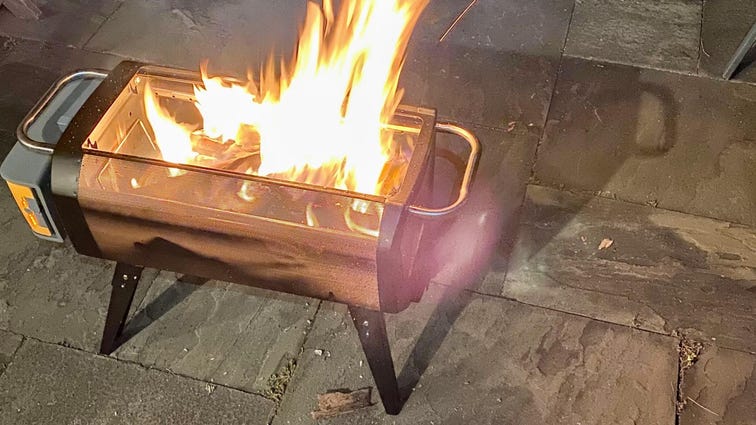

David Carnoy/CNET
The FirePit Plus, made by Brooklyn-based BioLite, weighs under 20 pounds and is built for portability. Measuring 27 by 13 by 15.8 inches, it’s relatively long and narrow, making it really good for patio use. However, it holds a little more wood than you’d think, with room for up to four cordwood logs. You can either use it as a standard fire pit or as a backyard grill and it was upgraded in 2021 with an enamel coating for easier cleaning and a higher-capacity battery for its built-in fan. It can also work as a patio heater.
In fire pit mode, you lower the fuel rack to the bottom of the pit. To use it as a free-standing grill, so you can cook over hot wood coals or charcoal briquettes if you prefer, raise the rack to its highest position. BioLite offers a bundle with a grill grate that sits over everything. The grill lit up fast, in less than 5 minutes, and was fully burning in less than 10.
The FirePit Plus has a couple of signature features, one being patented airflow technology. A motorized fan powered by the flames’ heat output drives air to the fire box. You can also control it using an iOS or Android app on a phone using Bluetooth. A mesh body lets you see flames through the FirePit from any angle.
In the new version, battery life has improved by about 20%, with up to 30 hours at the low setting, 14 hours on medium and 7 hours on high. The airflow technology also helps create an almost smoke-free fire, making it suitable as a patio heater. The FirePit Plus’ legs fold up when you want to take the grill on the go, plus the pit comes with a handy rain cover. A removable ash tray makes cleaning up easy.
All in all, this is a compelling little fire pit for someone who doesn’t want (or can’t have) a permanent pit always eating up patio space.

 \n ","topic":"","ttag":"","variant":"","viewguid":"","event":"listicle|image|5","correlationId":"","_destCat":"https:\/\/www.lowes.com\/pd\/Garden-Treasures-29-5-in-W-Black-High-Temperature-Painted-Steel-Wood-Burning-Fire-Pit\/3819935","productName":"Best fire pit value","formatType":"IMAGE","location":"LIST","position":5,"sku":"","dwLinkTag":"article-body|listicle|image","selector":"#article-body #listicle-1a08e4ef-ea1b-4e42-920c-00c640d58a6d .itemImage"}}” rel=”noopener nofollow” target=”_blank”>
\n ","topic":"","ttag":"","variant":"","viewguid":"","event":"listicle|image|5","correlationId":"","_destCat":"https:\/\/www.lowes.com\/pd\/Garden-Treasures-29-5-in-W-Black-High-Temperature-Painted-Steel-Wood-Burning-Fire-Pit\/3819935","productName":"Best fire pit value","formatType":"IMAGE","location":"LIST","position":5,"sku":"","dwLinkTag":"article-body|listicle|image","selector":"#article-body #listicle-1a08e4ef-ea1b-4e42-920c-00c640d58a6d .itemImage"}}” rel=”noopener nofollow” target=”_blank”>
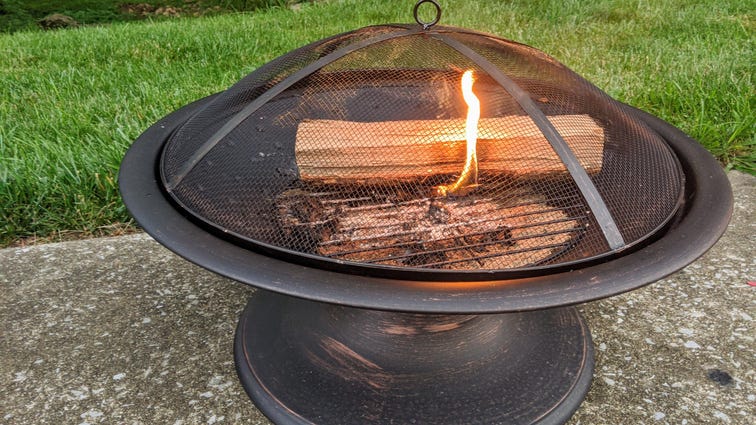

Brian Bennett/CNET
This fire pit from Garden Treasures (Style Selections) proves you don’t need to spend big bucks to enjoy a backyard campfire. Despite its low price, this wood burning pit is nice and wide (29.5 inches in diameter). It also comes with a mesh spark screen lid to keep embers at bay.
It lacks an advanced airflow system, however, so fires in this wood burning fire pit generate a lot of smoke. And its steel frame isn’t stainless, so leaving the pit out in the elements will invite rust. That said, we were able to get a self-sustaining fire lit in about 5 minutes. Its ignition time is comparable to those of premium fire pits such as the Solo Stove Ranger and Tiki Brand Fire Pit.
Those products burn their fuel more efficiently, leaving less unconsumed firewood and ash to clean up in the morning. Still, the Garden Treasures wood burning pit does get the job done on a tight budget.
Others we tested
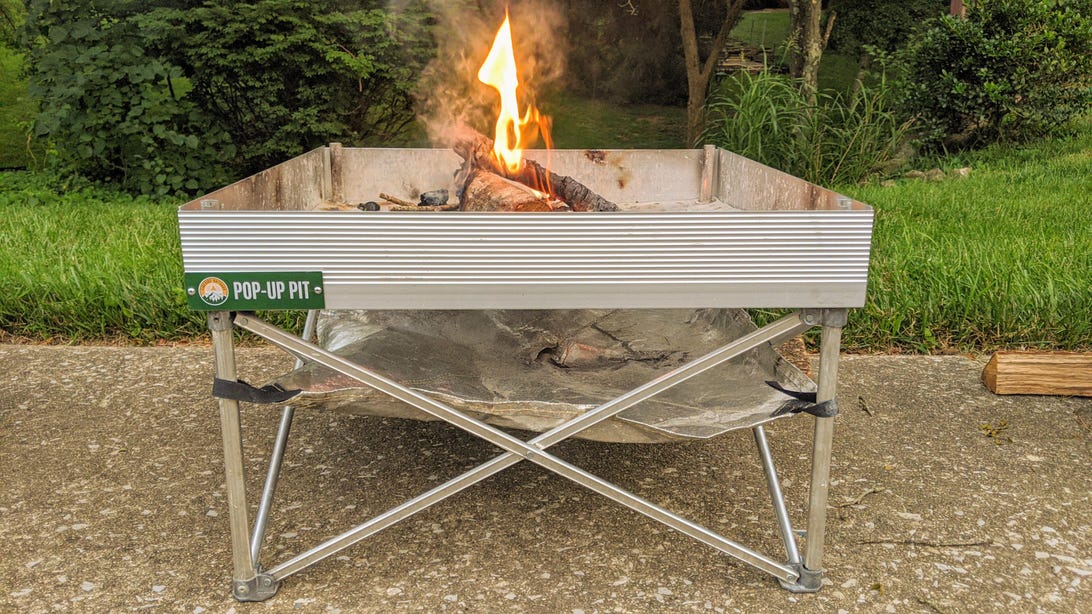
The Pop-Up Fire Pit is very portable but makes a lot of smoke.
Brian Bennett/CNETPop-Up Fire Pit: The most portable fire pit idea in this roundup is the Pop-Up Pit. Its collapsible design lets you assemble it and break it down quickly. It also uses a heat shield so it won’t scorch the ground below. The pit offers a large (2-foot-square) burning surface for your fire, too. Since its frame is constructed from stainless steel, the Pop-Up Pit is rust-resistant. However, because the pit is so large and has low walls, it creates a lot of smoke.
Solo Stove Ranger: Squat, cylindrical, compact and made from stainless steel, the Solo Stove Ranger appears simple at first glance. Tucked away inside this pit, though, is the same sophisticated airflow system that its larger sibling, the Solo Stove Yukon, has. The system is designed to enable fire in the pit to burn hotter and consume more of its wood fuel.
We can confirm that the Ranger delivers on these promises. It starts fast, with its logs aflame in just 5 minutes, and it burns for hours. The fires we started in the Ranger also burned with incredible ferocity. The flames inside the pit focused into an impressive rolling vortex. Despite the conflagration, the Ranger emitted very little smoke.
The Ranger does have a few drawbacks. Its compact size means it can’t accept standard 15-inch firewood logs. It’s also not the best for large groups or families. More than two people roasting marshmallows at once quickly becomes a crowd.
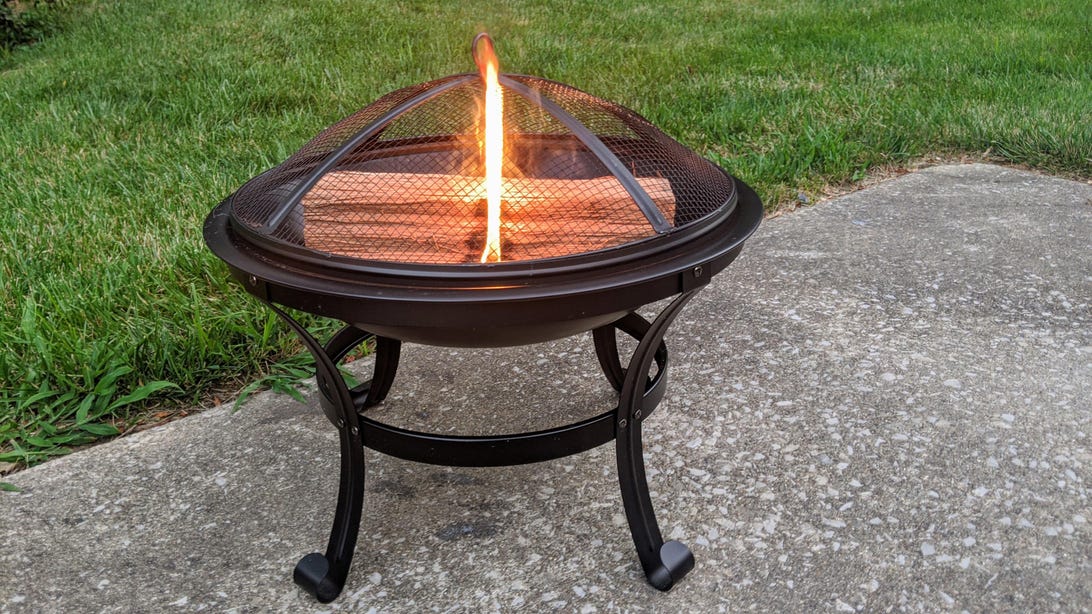

The Kingso 22-inch fire pit is small and has poor airflow.
Brian Bennett/CNETKingso Outdoor Fire Pit (22-inch): Though it’s a bestseller on Amazon, we don’t recommend purchasing the Kingso Outdoor Fire Pit. Its small size (22 inches in diameter) feels cramped. And since airflow throughout the small fire pit unit is poor, we consistently had difficulty both starting fires and keeping them lit inside this pit. It doesn’t come with a protective cover, either.


The Hampton Bay Windgate 40-inch Dia Fire Pit is massive and built from heavy steel. Unfortunately, it suffers from poor airflow so its flames often die out.
Brian Bennett/CNETHampton Bay Windgate 40-inch diameter round steel wood-burning fire pit: The Hampton Bay Windgate is by far the largest fire pit in this group. It has a massive 40-inch-diameter fire bowl, roomy enough for big groups to gather around. As the pit weighs in at a substantial 60 pounds and is constructed from heavy-duty steel, it takes a lot of effort to set up the pit where you want it. Unfortunately, the Windgate steel fire pit suffers from poor ventilation. As a result, fires we started in the pit consistently died out in 15 to 20 minutes. That makes it difficult to recommend this wood-burning pit model.
A good fire pit will ignite in minutes and stay lit for hours.
Brian Bennett/CNETHow we evaluated them
To test each fire pit, we used the same fuel, Simple Simon Premium Hardwood sourced from a local Lowe’s. For a consistent amount, we selected three split log lengths roughly 15 inches long. We then stacked the logs together so at least some portion of each was touching the others.
To ignite each pit, we used Diamond Strike-a-Fire fire starters that were available at our neighborhood Kroger supermarket. One of these starter matches should be all that’s required to get a fire pit’s fire burning. We then logged how long it took to establish a fully sustained fire.
A good fire pit will fully ignite in 5 to 10 minutes. A pit with poor airflow and design will take a lot longer, or even flame out after 15 minutes no matter how well you’ve stacked your wood. Additionally, we made note of how much smoke escaped each pit. Ideally, a fire pit will generate a lot of flame and little smoke. A quality fire pit will also burn fuel efficiently, leaving little solid material remaining once its fire burns out naturally.
Fire pit FAQs
What is the best type of fire pit to buy?
The type of fire pit you should purchase depends on two main considerations. First is how much money you plan to spend. For instance, inexpensive pits are almost always basic cast-iron models that lack fancy smokeless airflow systems. The second factor to think about is how you’d like to use your pit. Simple pits provide the heat, sights and sounds of a crackling fire. They’re also fine for making s’mores and the odd hot dog. For more advanced cooking capabilities you’ll have to spend more for a pit also designed to operate as a true outdoor grill.
Which fire pits give off the most heat?
While all fire pits generate heat, some tend to create more than others. Ordinary pits, which are also the cheapest, can put out a good amount of heat. Unfortunately they typically create a lot of smoke as well. Smokeless fire pits do reach higher temperatures since they’re designed to foster a high degree of airflow as they burn. However, in my experience, Solo Stove fire pits channel much of their heat upward. Breeo pits, on the other hand, tend to push more heat outward so you often feel their warmth more.
Which smokeless fire pit is the best?
From a pure smokeless performance standpoint, Solo Stove fire pits are the best. They’re the easiest to start and keep lit. They also produce the least amount of smoke and generate the most intense, eye-catching flames. That said, since Solo Stove pits push much of their heat upward, they’re not ideal for keeping seated groups comfortable on cold winter nights. And they’re not designed for cooking elaborate outdoor meals either.
